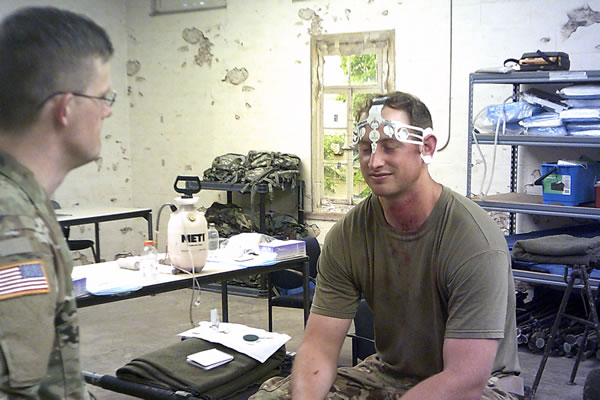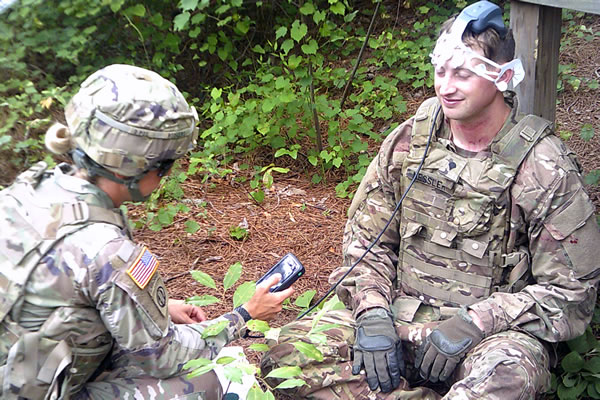Army Operationally Tests Brain Injury Evaluation Devices


The U.S. Army Medical Research and Materiel Command coordinated testing of two medical devices including the BrainScope One® (Ahead 300©) and the Infrascanner 2000™ to address a critical capability gap – the ability to quickly and effectively assess the existence and relative severity of brain trauma, before a patient reaches advanced hospital care.
The devices could potentially augment the Military Acute Concussion Evaluation process (MACE; https://dvbic.dcoe.mil/material/mace-military-acute-concussion-evaluation-pocket-card), which is the current standard for assessing Soldiers that may have suffered a traumatic brain injury.
Both devices are small, light-weight, non-invasive and designed to take less than 10 minutes to use. Additionally, both devices are already cleared by the U.S. Food and Drug Administration. However, FDA approval does not automatically mean a device or product is best suited to address both the military operational need and the military operational environment.
Military operational environments may be snowy mountain tops or hot, sandy deserts – and everything in between. A medical device that works well in a clean, clinical setting may not be as easy to use or effective on a sweaty, dirty or bleeding Soldier. Many hospitals also have specialists, such as neurologists, available to examine and diagnose patients. However, on the battlefield, these experts are often not readily available at the point of injury to assess a wounded warfighter and determine the need for medical evacuation.
Additionally, the Army must consider logistics. To ease the logistical burden, the Army seeks equipment and supplies that are as small and light-weight as possible. Costs are also important. Products and devices must be cost-effective to buy, maintain and sustain long-term.
To find out if either device meets the military's full needs and is logistically supportable in an operational environment, product managers from the USAMRMC, in conjunction with the Army Medical Department Center and School and the U.S. Army Medical Department Board, coordinated with other military units willing to take one type of device and test them in the operational environment. User feedback will help shape future concept of operations, training, procurement, operations and maintenance, and sustainment plans for the devices – should either device provide to be a viable solution.
"User feedback is essential to this evaluation process," said Brian Dacanay, a product manager assigned to the U.S. Army Medical Materiel Development Activity (USAMMDA), a subordinate organization of USAMRMC. "If results of the operational clinical assessment, environmental testing and data collection are promising, we may then pursue follow-on activities to support fielding of this capability."
While both devices have the same goal of detecting brain trauma, they function differently. The Infrascanner 2000™ is a handheld device that use near-infrared spectroscopy to detect superficial bleeding in the brain. The BrainScope One® device analyzes the electrical activity of the brain to identify brain injury. Both devices detect brain injury that would be visible on computed tomography (CT) scan, the definitive platform for brain injury detection in the military operational environment.
"Based on size and weight of the devices, our team believes that these devices would be most suited for battalion aid stations, forward resuscitative surgical teams and combat support hospitals," said Dacanay. "It is important to note, however, that neither device we are evaluating is approved to replace an actual CT of the head. These devices can only be used to support a clinical evaluation of a traumatic closed-head injury."
Dacanay also explained that these two devices are not the only potential brain injury tools in development. USAMRMC is currently spearheading brain injury detection and diagnosis efforts focused on wearable sensors with detection algorithms; handheld laboratory tests using blood sample biomarkers; and devices that measure and monitor physiological parameters relevant to moderate and severe brain injury.
"Medical providers routinely evaluate conditions using multiple approaches from blood tests to measuring changes in the function of the body. We are pursuing the same types of solutions for brain injury," USAMMDA Project Manager Lt. Col. Kara Schmid. "The brain is a complex organ and traumatic brain injuries are exceptionally diverse. We believe the best approach to finding the right solutions is to develop multiple modalities that can provide information on the brain from cellular to physiological changes."
Brain injury diagnosis and treatment remains a top medical priority for the military. The Defense and Veterans Brain Injury Center estimates that nearly 380,000 service members have sustained brain injuries since 2000.













